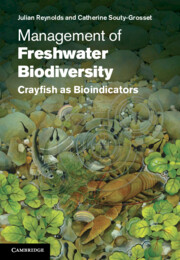Book contents
- Frontmatter
- Contents
- Preface
- Acknowledgements
- Introduction: Biodiversity in freshwater systems, and the key roles played by crayfish
- Part I The present situation of crayfish in world freshwater ecosystems
- Part II Applying science to conservation management
- Part III Knowledge transfer for successful crayfish management
- 10 Effective legislation and public education for adequate conservation of crayfish and biodiversity
- 11 Management strategies to protect crayfish and biodiversity
- 12 Maintaining biological diversity and human well-being
- References
- Glossary
- Index
- Scientific and common English names of well-studied crayfish featured in this book
- Common English and scientific names of well-studied crayfish featured in this book
- Plate section
11 - Management strategies to protect crayfish and biodiversity
from Part III - Knowledge transfer for successful crayfish management
Published online by Cambridge University Press: 05 December 2011
- Frontmatter
- Contents
- Preface
- Acknowledgements
- Introduction: Biodiversity in freshwater systems, and the key roles played by crayfish
- Part I The present situation of crayfish in world freshwater ecosystems
- Part II Applying science to conservation management
- Part III Knowledge transfer for successful crayfish management
- 10 Effective legislation and public education for adequate conservation of crayfish and biodiversity
- 11 Management strategies to protect crayfish and biodiversity
- 12 Maintaining biological diversity and human well-being
- References
- Glossary
- Index
- Scientific and common English names of well-studied crayfish featured in this book
- Common English and scientific names of well-studied crayfish featured in this book
- Plate section
Summary
Biodiversity in fresh waters
In most countries today there are marked gradients in species distribution and richness, often arousing some concern. Such gradients may be produced by natural drivers, including evolutionary pressures through habitat restriction, isolation, change over time associated with mountain building or infilling of lakes, and climatic change. However, observed gradients in biodiversity in fresh waters are frequently due, directly or indirectly, to human intervention – diffuse or point source pollution, climate change and introduced alien species – resulting in local biodiversity loss. Conservation of wetland biodiversity is complicated by the landscape position of rivers and wetlands as ‘receivers’ of land-use effluents, and by competition for fresh water between many different human stakeholders, usually in denial of the need to protect the resource. Even if the headwaters of a catchment maintain biological diversity that underpins ecosystem services, this biodiversity is easily threatened because of the small size and fragmentation of these habitats.
Decapods are important in many freshwater bodies, and we have concentrated on indigenous crayfish as indicators for biodiversity, on their threats and losses, and on management to restore them. There are hundreds of freshwater crayfish species, chiefly in temperate and subtropical zones, and twice as many species of freshwater crab, reflecting their more restricted ranges in the tropics. Indigenous crayfish species are often important components of freshwater communities, acting as keystone species in shaping community function and biodiversity. There are major crayfish threat hot-spots in the south-east of North America and southern Australia. Over half of North American crayfish are considered at risk (Jay Cordeiro, personal communication, 2010), while almost half of all Australian crayfish are considered to be threatened because of habitat loss and degradation, and the effects of climate change, further exacerbated by their small ranges (Nadia Richman, personal communication, 2011).
- Type
- Chapter
- Information
- Management of Freshwater BiodiversityCrayfish as Bioindicators, pp. 271 - 284Publisher: Cambridge University PressPrint publication year: 2011



